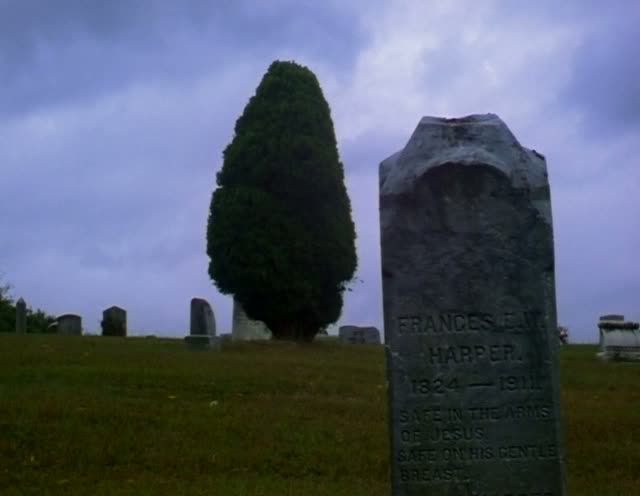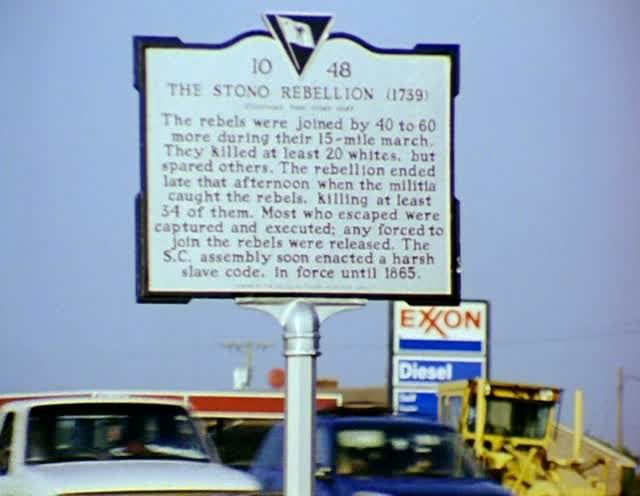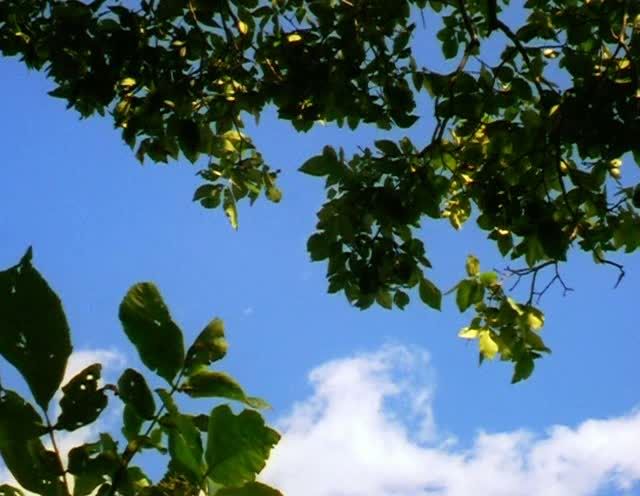

John Gianvito's Profit Motive and the Whispering Wind is a simple but evocative documentary, a film that chronicles the history of American rebellion, resistance and progressivism, using monuments, gravesites, plaques and other commemorative relics to chart the various social, political and economic struggles of American history. The memorials that Gianvito captures in his sumptuous images — invariably backed by bright blue skies, fluffy clouds and lush green vegetation — are mostly public, with many familiar names and events highlighted, but the way he presents these finds has the feel of gathering evidence, silently making an argument through the accumulation of details. The film progresses roughly chronologically through American history, beginning with monuments to battles against Native Americans and moving on to chronicle slave rebellions, women's rights reformers, and especially the often violent struggles of the labor movement. Gianvito makes his perspective clear early on, when he films a sign about how colonial forces "defeated" the Indians in a battle: after an abrupt cut, the word "defeated" has been crudely papered over with a cardboard cutout replacing the word with "massacred." It's an acknowledgment that, within these nominally objective markers of history, there is a distinct slant, one that Gianvito is endeavoring to replace with his own slant and his own perspective.
For most of the film, though, the filmmaker simply observes and edits together these memorials and graves into a kind of alternative history of America. There are familiar names here, names inscribed in any high school history textbook, but their graves, their grand monuments, are scattered in with the more modest memorials to other martyrs and thinkers, names not so familiar, names and events that don't get taught in American classrooms. Gianvito, building on Howard Zinn's A People's History of the United States, is paying tribute to the people, both famous and forgotten, who contributed to this country's history of struggle and reform. The sheer proliferation of small civic plaques commemorating the various massacres and tragedies of the labor movement itself makes a statement: so many plaques stoically recounting 19 dead here, 38 wounded there, a list of names with ages, some of them as young as six years or even six months old, another monument that documents how each of the men was killed (bullet through the heart or head) and who they left behind when they died. All the facts and figures, the years and dates, the cold hard recitation of facts about people who lived, fought and died for something they believed in. All the graves, all the forgotten heroes who died to get an eight-hour work day, to protest unfair business practices, to earn benefits that they would never enjoy themselves, but which would be passed on to future generations. One man was, his grave tells us, killed "by capitalist interests for organizing and inspiring his fellow man," a worn inscription that Gianvito finds important enough to emphasize by, for a moment, digitally enhancing the letters on the grave so they stand out clearly enough to be read.
These still, quiet images of graves and monuments are alternated with equally languid images of the wind whispering, whistling and murmuring through trees, fields of flowers, and undulating meadows of tall grass. The film quickly falls into a slow, steady rhythm: an image of untouched natural splendor, then a gravesite, surrounded by tranquil fields, buried in grass or shaded by trees, sometimes with lichens and mold wearing away the stone, sometimes with insects creeping along the cool surface of the tombstone. These images, mostly filmed in the American Northeast on bright, nearly cloudless summer days, are gorgeous and peaceful. There is rarely any direct sign of human presence — only in one shot does Gianvito capture, almost incidentally, some tourists walking along a path, distant from the grave he's shooting. The absence of any visitors to these monuments suggests a forgotten history, even if Gianvito is freezing these sites in place at moments of stasis. Many of these graves are marked with flowers and other signs of recent visitation, so the film's stillness and lack of population feels artificial, stylized, a bit of poetic license to make a political point: how easy it is to forget, to ignore the past, to walk by the lessons of history without pausing to consider them.


Some of these monuments are clearly marked and public, others are shrouded in trees, hidden away in private corners, decaying with age and rot. Gianvito introduces an image of an empty field with a paragraph of text citing a labor martyr and his unmarked grave, hidden beneath the field with no sign or monument to announce his presence or his role in history. A monument to one of many labor massacres is mounted at the base of a lamppost in a shopping mall by a major thoroughfare, a perfect example of capitalist practicality co-opting a memorial to its enemies. The film, by juxtaposing monuments placed in prominent, public view with those that are more obscured, calls attention to the vagaries of history. Gianvito, without saying a word, is asking us to question why and how we remember, and what we remember: who gets enshrined in history books, who gets a big tourist site memorial, and who gets shuffled off into a corner, buried in an out-of-the-way cemetery with only a small marker to commemorate their lives and actions.
At one point, Gianvito films a sign whose text briefly describes a 1759 slave rebellion (failed, naturally). He holds an angled shot of the sign for long enough for its text to be read, and then cuts to a different angle, revealing the very different sign in the background: an Exxon gas station sign, with cars speeding by on a highway between the rebellion memorial and the list of gas prices. The revelation recontextualizes this monument, revealing its awkward positioning by a road where it could hardly be read by all the cars speeding by, and revealing its proximity to the signifiers of modern American prosperity and commerce. By and large, these signs of progressive history are positioned within a society that is rushing ahead, not pausing to read the epitaphs on these obscure graves, not caring to be educated about the revolts and struggles described by roadside plaques. Even when modernity isn't so intrusive within the frame, it's often in the background, as Gianvito's meticulous sound design lets in the roar of passing trucks, the hum of a lawnmower, the distant buzz of what might be the titular wind, or else the traffic on a nearby motorway.
It's only at the end of the film that this timeless, methodical examination of history's uneasy position in the present gives way to a full-on embrace of the now. After filming several high-profile capitalist brands — McDonald's, Walmart — through the film's signature waving leaves and branches, Gianvito introduces a briskly edited sequence of present-day protests against the Bush administration and the Iraq war. It's an attempt — perhaps a strained one — to link the film's history of struggle to modern resistance and protest. Gianvito's evocation of different flash points in American history — the oppression of Native Americans, the slave rebellions, the fight for women's suffrage, the violence against labor unions — suggests that oppression is a constant, and so too is the resistance against it. In this context, the ineffectual Bush-era protests clearly lack the gravity or the air of importance of the other historical touchstones of Gianvito's film, but his point with this coda remains powerful: the need to struggle, to fight for the next advance, the next small victory for the under-represented. This poetic, evocative film beautifully captures the urgency of such struggles while paying tribute to those who struggled, won, lost, lived and died, and were feted or forgotten by history.

6 comments:
"The film quickly falls into a slow, steady rhythm: an image of untouched natural splendor, then a gravesite, surrounded by tranquil fields, buried in grass or shaded by trees, sometimes with lichens and mold wearing away the stone, sometimes with insects creeping along the cool surface of the tombstone."
Indeed Ed! This is a beautifully written piece on a film that sadly few have seen. Fortunately I saw it last year at the Anthology with Lucille, briefly assessing it at the Diary with a 3.5/5 rating. At it's best, Gianvito accomplishes what you lovingly relate here, but I found at times the focus meandered from the general purpose, and at the these junctures it was grueling, but in the end one must applaud the director for his wholly original vision and auspicious attempt to bring a vital connection from the past to the present.
Good to see someone else has seen this, Sam, I'm sure that other than its run at Anthology it hasn't gotten around much. About the only thing I didn't like about it were those little animated inserts that didn't add much, but they were a pretty insignificant portion of the whole. The actual footage of the graves and plaques, and the nature footage, were gorgeous, hypnotic, and slowly added to the film's overall thrust. I found it enthralling pretty much throughout.
Interesting that you would write about Gianvito, Ed! He's a professor at my school, and is the faculty advisor of the film criticism magazine I run. Haven't yet seen Profit Motive unfortunately, but Mad Songs of Fernanda Hussein is certainly of interest if you haven't seen it.
Very interesting, Carson! I'll definitely be checking out Mad Songs at some point, it sounds fascinating, and I loved Profit Motive. He's obviously a very interesting filmmaker. Have you heard anything about his more recent film Vapor Trail (Clark)? It also sounds pretty amazing.
Yes, I've heard a lot about Vapor Trail. Someone I worked with at the school's library was the film's assistant editor, and it premiered at the Harvard Film Archive, where Gianvito was once the head curator. I missed the screening myself, but it sounds like a sprawling, ambitious documentary.
Cool. Hopefully I'll be able to catch it eventually as well.
Post a Comment